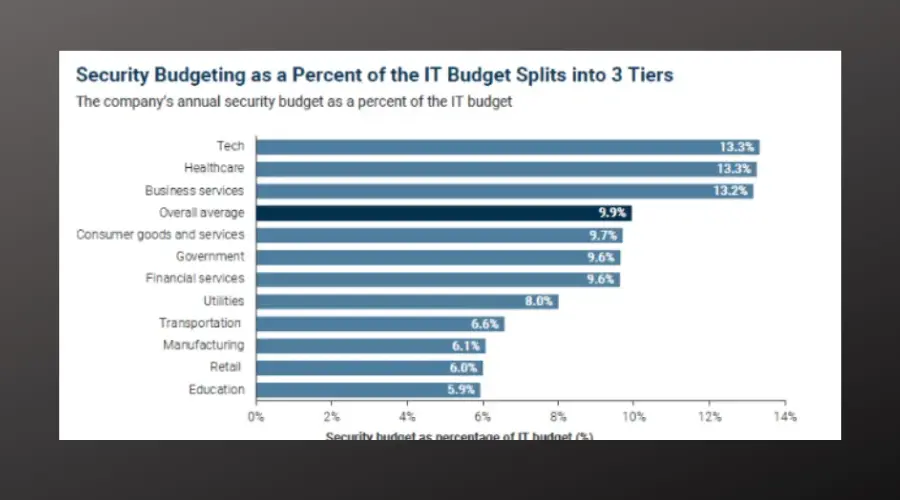Billions of dollars go into cybersecurity spending every year.
Businesses simply can no longer afford to ignore their online protection due to the increased threats of attacks from hackers and cybercriminals.
Based on this fact, let’s take a look at some key cybersecurity spending statistics that will make your jaws drop.
Contents
Jaw-dropping cybersecurity spending statistics
Here are some cybersecurity spending statistics that give an insight into how much money countries and companies spend to protect themselves from cybercrimes and attacks.
- In 2022, an estimated $171.4 billion was spent on cybersecurity. It grew in 2023 to approximately $219 billion, and this figure is expected to rise to $262 billion in 2026.
- Global cumulative cybersecurity spending already surpassed $1 trillion since 2021. Relevant estimates also show that the cumulative spending between 2021 and 2025 alone will amount to $1.75 trillion.
- Global spending on cyber insurance products is predicted to hit $14.8 billion yearly by 2025. This signifies a rising from initial estimates of $8.5 billion in 2021.
- The global financial losses due to cybercrime currently stand at $2 trillion. The figure rises to $6 trillion for all types of cyberattacks.
- The US government’s cybersecurity budget for 2023 is $10.89 billion, and the Department of Homeland Security will receive an estimated $2.6 billion from this budget.
General cybersecurity spending statistics
Here, you’ll get a deeper look at some noteworthy cybersecurity spending stats.
1. Microsoft has spent $1 billion yearly on cybersecurity since 2015
(Source: CNBC, Microsoft Blog)
This is due to the company’s aim of developing better infrastructure and cybersecurity products to detect, protect, and prevent its consumers from security threats.
2. Google and Microsoft are on course to invest more than $30 billion over 5 years to strengthen global cybersecurity efficiency
(Source: CNBC, Microsoft Blog)
Since 2021, Google planned to invest $10 billion over 5 years in its Career Certificate Program to train 100,000 Americans in specialized cybersecurity fields such as data analytics and IT support.
Similarly, Microsoft also pledged to spend $20 billion over a 5-year period to develop stronger security tools.
3. JPMorgan Chase spends $600 million on cybersecurity yearly
(Source: JPMorgan Chase)
This marks a $100 million increase in its annual online protection budget. The company currently has over 3,000 employees working in its cybersecurity division.
4. Global spending on cybersecurity training will hit $10 billion by 2027
(Source: Cybersecurity Ventures)
According to forecasts, tech giants including Google, Microsoft, IBM, Amazon AWS, and more are just a few of the global companies that will invest in training their employees on cybersecurity best practices to the tune of $10 billion by 2027.
5. The global cybersecurity market will be worth $352.5 billion by 2030
(Source: P&S Intelligence)
Among many other factors, the rapid adoption of cloud computing, IoT technology, and the increasing rate of cyberattacks are the driving forces behind this bold prediction.
Therefore, based on existing data, the market which was worth $171.9 billion in 2022 is going to grow at a CAGR (Compound Annual Growth Rate) of 9.4% to $352.5 billion by 2030.

6. Data breaches in the US cost $4.2 million on average
(Source: IBM Data Breach Report)
Additionally, the value jumps up to $52 million on average for data breaches that involve between 1-10 million records.
7. A new cyber attack happens every 39 seconds
(Source: University of Maryland)
Cyber crimes have increased drastically since the covid-19 pandemic crisis. Reports now show that a new cyber attack happens every 39 seconds, with phishing accounting for 80% of all reported cases.
8. US companies pay up to $500,000 to hackers to test their security
(Source: CNBC)
Big US companies including Tesla and Mastercard organize public bounties where freelance white-hat hackers get rewards for finding holes in their security systems. Furthermore, the top 50 hackers get average payouts of $145,000 yearly.
9. UK’s cybersecurity sector has generated £10.5 billion in 2023
(Source: Gov.uk)
This marks a 3% increase in the reported revenue of £10.1 billion from 2022.
In addition, the report also shows that the number of cybersecurity companies in the country has increased from 1,838 to 1,979. This has led to the creation of over 5,000 new jobs.
Cybersecurity spending by country
Below is the cybersecurity spending by country ranking:
- United States – $10.89 billion allocation for 2023 and approximately $12.7 billion for 2024.
- The UK – £114 million in additional allocation in 2021 and a £2.6 billion budget for cyber security and legacy IT over a stretched review period.
- Israel – Government spending figures are unclear, but the country’s private investment funding for cybersecurity in 2022 was $3.84 billion, and $8.84 billion in 2021.
- Germany – Government cybersecurity spending figures are unclear but as of 2019, the country has already spent €3.5 billion on IT projects since 2015.
- France – Most recent data shows a €1 billion investment in 2021, with €350 million dedicated to hospitals.
- Canada – $875.2 million over 5 years, starting from 2022-2023
Now let’s see how these figures translate when it comes to industries.
Cybersecurity spending by industry
Based on available data from 2022, companies dedicated an average of 9.9% of their IT budgets to protecting and strengthening their online security.
However, Below is the full cybersecurity spending by industry ranking:

- Tech – 13.3%
- Healthcare – 13.3%
- Business services – 13.2%
- Consumer goods and services – 9.7%
- Federal Governments – 9.6%
- Banking and financial services – 9.6%
- Utilities – 8%
- Transportation – 6.6%
- Manufacturing – 6.1%
- Retail – 6%
- Education – 5.9%
The fact that the education industry is one of the lowest cyber security spenders is a worrying sign for many analysts.
However, it may also be a sign that the industry is not as lucrative to target as others like the tech, healthcare, and business services industries.
Wrap up
These stats paint a vivid picture of the extent of cybercrime and how much businesses are spending to protect their data and finances from cybercriminals.
FAQ
What percentage of IT spend is cybersecurity?
According to 2020 stats, businesses spent between 7.2% to 12% of their IT budget on cybersecurity.
These figures are only expected to maintain an upward trend.How much is estimated to be spent on cybersecurity worldwide?
Global spending on cybersecurity has already exceeded $1 trillion since 2021. However, estimates show that worldwide spending on cybersecurity will hit $1.75 trillion between 2021 and 2025.
How much money is in the cybersecurity industry?
This year alone, cybersecurity spending will exceed $219 billion. According to predictions, by 2026, the figure will increase to $300 billion, and $352.5 billion by 2030.
How much of global GDP is cyber security?
Cybercrime damages are going to account for 8% of global GDP by 2025 according to available data. In figures, this translates to $8 trillion out of the $94 trillion global GDP forecast.
Sources:
- Statista
- Microsoft
- IBM Data Breach Report
- CNBC
- Forbes
- Cybersecurity Ventures
- P&S Intelligence
- Cybersecurity Ventures
- CNBC
- The White House
- Cybersecurity Ventures
- Forbes
- Cybersecurity Germany
- Gov.UK
- CNBC
- Gov.UK
- ConnexionFrance
- Government of Canada
- JPMorgan Chase
- University of Maryland
- Cybersecurity Dive
- SEON


